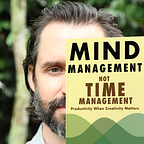Why did it take so long for “time management” to be invented?
Is “mind management” the next productivity paradigm?
Sometimes a discovery takes way too long to happen.
We had luggage for a long time, and we had wheels for a long time, but we were deep into the 20th century before someone put wheels on luggage.
The Mayans had wheels on their kid’s toys, but still didn’t have wheeled carts for transportation.
One invention that took too long to happen was time management.
It’s not clear exactly when time management was invented. But we do know Leonardo kept very long lists of things he’d like to accomplish with his time, like Draw Milan, and Get the master of arithmetic to show you how to square a triangle. Leonardo also created one of the first time-and-motion studies in trying to manage the manpower required to divert the Arno river, while helping Florence attempt to conquer Pisa.
Most of us have seen Benjamin Franklin’s daily schedule, circa 200 years ago, outlining when he would work, sleep, and address Powerful Goodness.
Apparently a consultant told steel magnate Charles M. Schwab to write and prioritize a list every day. The tip was so valuable Schwab voluntarily gave that consultant today’s equivalent of nearly half a million dollars. This was in 1918.
The oldest “time management” book I could track down was The Time Trap, published in 1972. How to Get Control of Your Time and Your Life followed soon after in 1973. It was one of Bill Clinton’s favorite books.
Time management is so widespread, few people can afford not to manage their time. You’ll have a hard time competing over resources if you don’t manage your time.
Most of us have full calendars, multiple todo lists, and the more efficient have graduated to managing attention through a system like GTD.
So, what took so long?
Consider how “stuff” turns into “things.” Our world is full of boundless phenomena. This is “stuff”—things like air temperature, light, and time. The world is also full of phenomena with boundaries, such as an acorn, a lake, or your own body.
When you take “stuff” and make it into a “thing,” it can become controlled and optimized. When a “stuff” is turned into a “thing,” it moves humanity forward.
Consider color. Nature did not make “colors.” There is spectrum of radiation. A portion of that spectrum is visible to humans. Color is a “stuff.”
Some cultures only have a few widely-recognized color names. The Tsimané (native Amazons in Bolivia) have words for white, black, and red. The Papua-New Guinean language Berinmo has five words for colors.
Homer often referred to a “wine-dark” sea in Odyssey and Iliad. There’s speculation that this is because ancient Greeks didn’t think of dark blue as being different from dark red.
Meanwhile, there are eleven widely recognized color names in English.
Yet the screen you’re reading this on has millions of colors. Color recognized as “things.” There’s a numerical system for recognizing all of these colors. That allows for control and accuracy in conveying those colors.
Because the “stuff” of color was turned into a “thing,” you can read this article in type crisp enough to rival a printed book, you can be transported to Antartica to huddle in a squall with king penguins through a BBC documentary, or you can chat with your parents as if they were in the same room—despite them being on another continent.
Some things take a long time to be invented (or should I say discovered?) But soon after they become widely used, we take them for granted. We can hardly imagine not being aware of more than three color names. We can hardly imagine not being aware of wanting to get a certain number of things done in a certain amount of time.
Time management may be a given in most of the industrialized world, but its use is still spreading. As an American living in Colombia, I’m reminded nearly every day that Colombians have a different sense of time. (Personally, I hope they don’t change.)
So what comes after time management? We already have attention management. Next up, I believe, is mind management. More specifically, the management of creative energy.
I quadrupled my creative productivity by managing my mind. Sign up and I’ll send you the tools I count on »
